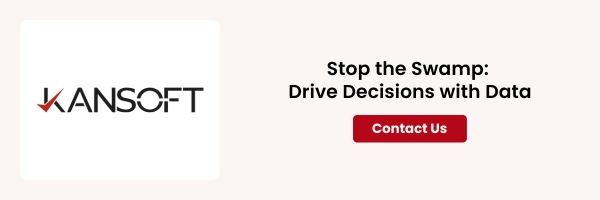As organizations become more data-driven in their decision-making, the demand for strong and scalable data architectures is growing rapidly. To meet this need, many enterprises are turning to data lakes—a flexible and scalable solution for storing large volumes of both structured and unstructured data. However, understanding the difference in the data lake vs data swamp scenario is critical. Without proper strategy and governance, these data lakes can quickly deteriorate into data swamps—disorganized, unusable repositories that hinder rather than help analytics efforts.
In this blog, we explore the critical differences between data lakes vs. data swamps, the reasons strategies fail, and how you can avoid common pitfalls.
What Is a Data Lake—and When Does It Become a Swamp?
A data lake serves as a centralized repository that enables the storage of data at any scale, regardless of type or structure. Unlike traditional data warehouses, it doesn’t require data to be structured before storage, which makes it ideal for handling big data and advanced analytics.
However, without data governance in data lakes, organizations risk creating an unstructured mess. When data is not properly cataloged, secured, or maintained, a data lake becomes a data swamp—a stagnant pool of data that is hard to navigate, let alone analyze.
Data Lake vs Data Swamp vs Data Warehouse: Understanding the Differences
Understanding the data lake vs data swamp vs data warehouse debate is essential for crafting a sound analytics strategy.
| Feature | Data Warehouse | Data Lake | Data Swamp |
|---|---|---|---|
| Structure | Highly structured | Semi-/unstructured | Unstructured, ungoverned |
| Use case | Reporting, BI | Big data, ML, advanced analytics | None—leads to inefficiencies |
| Data Governance | Strong | Requires planning | Often missing or weak |
| Accessibility | Easy for business users | Easy for data teams | Difficult for all users |
Today, many forward-thinking companies are moving toward a hybrid model called a data lakehouse—a modern architecture that combines the data lake’s flexibility with the structure and performance of data warehouses.
Why Your Analytics Strategy Might Be Failing
Many organizations make significant investments in data lakes but struggle to realize substantial returns.
Here’s why:
1. Lack of Metadata and Data Cataloging
If users can’t find or understand the data, they won’t use it. Without a proper cataloging system, your data lake is just a black hole.
2. Weak Data Governance
Without clear data ownership, access policies, and data quality checks, your analytics outputs will be unreliable. Effective data governance in data lakes is essential for maintaining consistency, ensuring usability, and meeting compliance requirements.
3. Security Risks
With vast volumes of sensitive data flowing in, data lake security can’t be an afterthought. Inadequate access controls and weak encryption practices can result in security breaches or regulatory fines.
4. Inadequate Architecture Planning
Choosing the wrong storage format, lack of scalability, or inefficient integration with analytics tools can cripple your system’s performance.
5. Siloed Team Ownership
When IT teams build lakes without involving business users or analysts, the resulting solution often misses the mark in terms of usability and relevance.
Best Practices to Prevent Data Swamps
To avoid the pitfalls and make your data lake strategy successful, here are some key practices:
- Establish strong governance: Define roles, data ownership, and approval workflows.
- Use a metadata catalog: Solutions such as AWS Glue, Apache Atlas, or Informatica help automate the creation and classification of metadata.
- Secure your lake: Ensure data lake security through role-based access controls, encryption, and regular audits.
- Monitor data quality continuously: Implement tools for anomaly detection, lineage tracking, and validation.
- Involve end-users early: Encourage collaboration between engineers, data scientists, and business teams.
The Rise of the Data Lakehouse: A Smarter Way Forward
The concept of the data lakehouse addresses many of the issues found in traditional lakes. It adds transactional support, metadata layers, and performance optimization, making it a versatile architecture for both raw and refined data workloads.
With a lakehouse, you get:
- Fast query performance like a warehouse
- Flexible schema evolution
- Unified governance tools
- Lower data duplication across teams
Case in Point: How One Healthcare Client Got It Right
A healthcare client of Kansoft recently migrated from a fragmented on-prem data warehouse to a secure cloud-based lakehouse. By embedding governance and using automation to tag data, they reduced report generation time by 60% and improved regulatory compliance.



